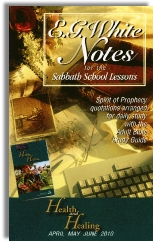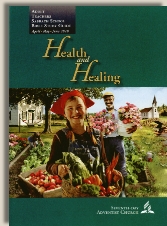|
||||||||||||||
Commentary on "Faith and Healing"
Day 2: Sunday, May 2, 2010
Day 3: Monday, May 3, 2010
Overview
“What are your fears? How have they affected your life? How can you better take advantage of the promises of God in dealing with things that make you afraid?” (Closing question for Sunday’s lesson)
Observations
T.S. Eliot wrote this in his poem, The Waste Land: “I will show you fear in a handful of dust.” I think he was talking about mortality. Any quick perusal of modern media demonstrates humanity’s obsession with youth. The very last thing most people want to admit is the passage of time, the wrinkling of skin, the loss of muscle tone, the loss of sexual drive, the possibility of dementia, and on and on. People will do anything and pay any amount to retain the smallest semblance of what they remember of themselves in their early 20’s.
The lesson does a nice job of capturing this root fear and describing the fears, real and imagined, with which we all live every day. Yes, it is good to fear a grizzly bear, and the shot of adrenaline may just save your life. No, it is not good to live in a constant state of fear – will I lose my job, will my kids turn out alright, am I getting fat, do you still love me… These irrational fears truly do sap our strength and ruin our health.
But notice the final question of the three quoted above, and this quote from Monday: “There is no question, even as Christians who believe in the existence of God, that we face a scary world out there, a world where anything can happen. With our knowledge of God, however, we have a context, a background, to help us better understand the world as a whole and our place in it. And thus, ideally, we can have hope and comfort even amid the most trying times. This does not mean we do not face bad things or things that can cause us to fear. It means, instead, that we have a firm foundation upon which to meet and deal with those fears.”
It takes much more than a belief in the existence of God to come to grips with fear in our lives. In their heart of hearts, even unbelieving scientists believe that there is something beyond what they know and can measure.
Fear is dealt with in only one way – the indwelling Holy Spirit. Without the Holy Spirit, we are left to cope with our world on our own. With the Holy Spirit, we know beyond all doubt that grace is sufficient, that His power is made perfect in our weakness (2 Corinthians 12:9-10). See also Philippians 4:4-9. This is the meaning of 1 John 4:18 referenced in the quarterly. Perfect love does not come on us from without. It flows through us from within, because the Holy Spirit makes it so.
The teacher’s comments section makes a bold claim, especially for an SDA publication: “Christians claim to believe that they have eternal life through a resurrected Savior. If we can trust God in the face of death, truly confronting that ultimate reality fearlessly, what else is there that Satan can use to scare us?”
No truer statement ever has been made in the quarterlies I’ve reviewed. However, the rest of the SDA belief system nullifies this boldness. If a person is expected to keep the Law, and the 4th Commandment in particular, in order to be saved; if a person cannot claim to have eternal life; if a person cannot know that Paul’s assertion of “absent from the body, present with the Lord” is a certainty, then how is that person supposed to trust God in the face of death? And if that person can’t really be certain regarding death, then he or she is left holding the bag, so to speak, with regard to the normal trials and tribulations of life.
My wife was an X-ray technician. At one time, she worked in the mammography lab at a hospital in Long Beach, CA. She was always fascinated (both sadly and joyfully) by the responses of the women who came through the department. Some were despondent, but some were not. One of the most memorable was a woman who had a tattoo on her arm. The numbers clearly identified her as a Holocaust survivor. When my wife asked her how she was holding up she replied, “After surviving this (pointing at her arm), cancer isn’t so bad.”
Every one of us bears the tattoo of sin in our flesh. It is just as real as the tattoo that any Jew received during World War II. When we accept the forgiveness Jesus provided on the cross by accepting the eternal life He offers us by virtue of His resurrection; that is, when we are born again of the Holy Spirit, we can deal with anything the world throws at us by saying, “After surviving this (pointing at our flesh), cancer and rebellious teens and the economy and politics and anything else in all creation is not so bad!”
Summary
- The lesson does a nice job of capturing the essence of fear – the fear of physical death that resulted from the spiritual death suffered by Adam and Eve when they sinned – and its corresponding symptoms. It also does a nice job of contrasting “good” fear and “bad” fear.
- The lesson is not strong enough in its assertion of the answer for fear. We don’t learn to move forward in spite of our fear because we know that God is more powerful, but because this omnipotent God actually lives inside of the born again believer.
Copyright 2010 BibleStudiesForAdventists.com. All rights reserved. Revised April 20, 2010. This website is published by Life Assurance Ministries, Glendale, Arizona, USA, the publisher of Proclamation! Magazine. Contact email: BibleStudiesForAdventists@gmail.com.
The Sabbath School Bible Study Guide and the corresponding E.G. White Notes are published by Pacific Press Publishing Association, which is owned and operated by the Seventh-day Adventist church. The current quarter's editions are pictured above.
Official Adventist Resources
Standard Edition Study Guide Week 6
Teacher's Edition Study Guide Week 6
Easy Reading Edition Study Guide Week 6
Search the Complete Published Ellen G. White Writings


